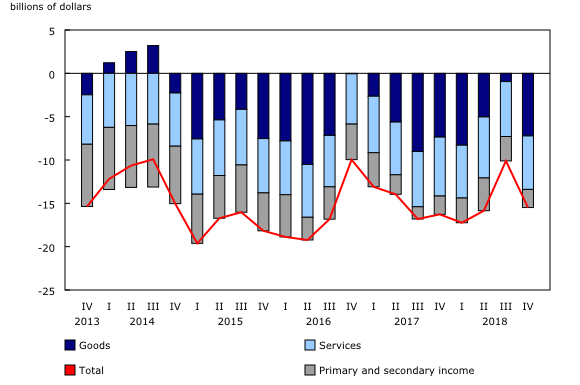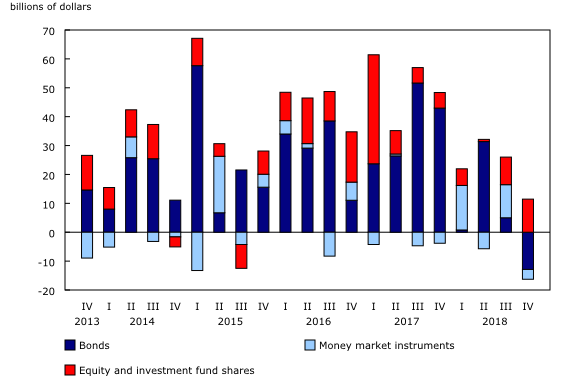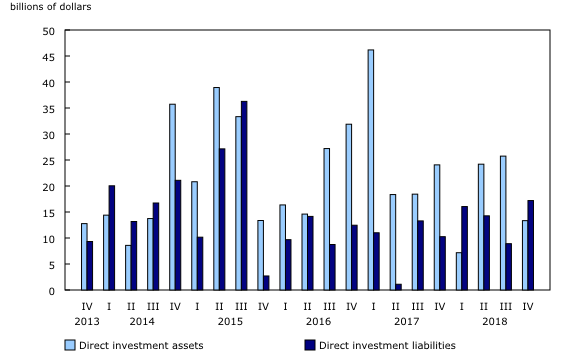Canada's balance of international payments, fourth quarter 2018
Archived Content
Information identified as archived is provided for reference, research or recordkeeping purposes. It is not subject to the Government of Canada Web Standards and has not been altered or updated since it was archived. Please "contact us" to request a format other than those available.
Released: 2019-02-28
-$15.5 billion
Fourth quarter 2018
Canada's current account deficit (on a seasonally adjusted basis) expanded by $5.4 billion in the fourth quarter to $15.5 billion. This increase reflected a higher trade in goods and services deficit, which was moderated by a lower investment income deficit.
The deficit on trade in goods and services rose by $6.1 billion. Exports were down by $7.3 billion to $175.1 billion, mainly on lower sales of energy products. This reflects a sharp decline in energy prices, which were down 22% in the quarter. Imports of goods and services declined by $1.1 billion to $188.5 billion. The deficit on primary income was reduced by $0.7 billion to $1.5 billion. Revenues earned by Canadians investors on their foreign assets were up in the quarter.
Inflows of funds from abroad to finance the current account deficit mainly came from transactions in currency and deposits. These transactions generated a net inflow of $38.6 billion, as non-residents significantly increased their holdings of currency and deposits in Canada.
Direct investment generated a net inflow of funds totalling $3.9 billion, as direct investment in Canada exceeded direct investment abroad for the first time in three quarters. These inflows of funds were partially offset by a strong decline in foreign holdings of Canadian debt securities.
In 2018, the current account deficit narrowed by $1.4 billion to $58.7 billion, the lowest deficit in four years. The trade in goods deficit declined by $3.1 billion, while the investment income deficit increased by $2.3 billion. The current account deficit has now declined for three consecutive years, from a peak of $70.5 billion in 2015.
Current account
Trade in goods deficit up sharply in the fourth quarter
After reaching a record $152.2 billion in the third quarter, exports of goods were down by $7.8 billion in the fourth quarter. Energy products accounted for most of the reduction in the value of exports, notably crude petroleum (down $7.5 billion). Crude petroleum prices declined nearly 50% in the last two months of the quarter. Higher exports of natural gas moderated the overall reduction in energy product exports.
Imports of goods were down by $1.5 billion in the fourth quarter. Energy products, basic and industrial chemical, plastic and rubber products, and motor vehicles and parts all contracted by $0.6 billion. Lower volumes imported were the main contributor to these decreases, except energy product imports, which declined on lower prices.
The trade in services deficit was down $0.2 billion to $6.2 billion in the fourth quarter, led by a higher commercial services surplus.
Lower deficit on investment income
The deficit on investment income declined by $0.7 billion to $0.9 billion in the fourth quarter. Profits earned by residents on their direct investment abroad increased by $1.2 billion to a record $19.0 billion. Meanwhile, profits earned by non-residents on their direct investment in Canada edged down for a second quarter in a row.
Financial account
Foreign holdings of Canadian securities decline for the first time since the end of 2008
Foreign investors reduced their holdings of Canadian securities by $4.8 billion in the fourth quarter, compared with a $26.0 billion investment in the previous quarter. Non-residents invested in Canadian shares, but significantly reduced their holdings of debt securities. This was the first divestment in Canadian securities since the fourth quarter of 2008.
Foreign holdings of Canadian bonds were down by a record $12.9 billion in the fourth quarter, led by strong divestments in December. Retirements of corporate bonds and sales of federal government bonds on the secondary market contributed the most to the decline. The Canadian dollar depreciated by 4.0 US cents against the US dollar in the quarter.
Direct investment in Canada exceeds direct investment abroad
Direct investment in Canada totalled $17.2 billion in the fourth quarter, the highest since the third quarter of 2015. Equity investments made by foreign parents in Canadian affiliates accounted for all of the activity in the quarter. Overall, direct investment in Canada was primarily from the United States and, to a lesser extent, France. Mergers and acquisitions activity totalled $5.9 billion, entirely on transactions from countries other than the United States.
Direct investment abroad slowed to $13.3 billion in the fourth quarter. About three-quarters of this activity was in the trade and transportation sector. Mergers and acquisitions activity totalled $4.5 billion, down from $17.7 billion in the third quarter. Canadian acquisitions of foreign firms ($16.0 billion) in the fourth quarter were moderated by sales of existing interest abroad ($11.4 billion). Issuances of new Canadian shares to non-resident portfolio investors partly contributed to the financing of the acquisition activity.
Note to readers
With this release, for the first time, an adjustment to the trade in goods was made to reflect the exports and imports of unlicensed cannabis. For now, this adjustment covers only the year 2018. For 2018, exports of unlicensed cannabis were estimated at $1.1 billion while imports of unlicensed cannabis were estimated at $0.3 billion. Changes to previous years will be implemented at the time of the third quarter release in November 2019. These data will also be implemented back to 1961 in the Canadian income and expenditures accounts with the fourth quarter of 2018 release. As a result, the Balance of Payments and Income and Expenditures Accounts import and export data will differ for the period 1961 to 2017. These differences will be minor and will be reconciled with the 2019 third quarter release of the balance of payments in November 2019. For more information about the methodology to estimate trade of unlicensed cannabis, see Cannabis Economic Account.
Despite the partial shutdown of the US federal government that ended in January, Statistics Canada was still able to integrate Canada's exports to the United States for December 2018 in the fourth quarter balance of payments. These data are sourced from the US Census Bureau. The monthly Canadian international merchandise trade data for December 2018 will be released March 6.
Definitions
The balance of international payments covers all economic transactions between Canadian residents and non-residents in three accounts: the current account, the capital account and the financial account.
The current account covers transactions in goods, services, compensation of employees, investment income and secondary income (current transfers).
The current account data in this release are seasonally adjusted. For information on seasonal adjustment, see Seasonally adjusted data – Frequently asked questions.
The capital account covers capital transfers and transactions in non-produced, non-financial assets.
The financial account covers transactions in financial assets and liabilities.
In principle, a net lending (+) / net borrowing (-) derived from the sum of the current and capital accounts corresponds to a net lending (+) / net borrowing (-) derived from the financial account. In practice, as data are compiled from multiple sources, this is rarely the case and gives rise to measurement error. The discrepancy (net errors and omissions) is the unobserved net inflow or outflow.
Foreign direct investment is presented on an asset-liability principle basis (that is, gross basis) in the financial account. Foreign direct investment can also be presented on a directional principle basis (that is, net basis), as shown in supplementary foreign direct investment tables 36-10-0025-01, 36-10-0026-01, and 36-10-0473-01. The difference between the two foreign direct investment conceptual presentations resides in the classification of reverse investment such as (1) Canadian affiliates' claims on foreign parents and (2) Canadian parents' liabilities to foreign affiliates. Under the asset/liability presentation, (1) is classified as an asset and included in direct investment assets, also referred to as direct investment abroad in this text, and (2) is classified as a liability and included in direct investment liability, also referred to as direct investment in Canada in this text.
For more information on the balance of payments, consult chapter 8, "International accounts," in the User Guide: Canadian System of Macroeconomic Accounts, available on our website. The chapter also presents the most recent balance of payments statistics.
Real-time table
Real-time table 36-10-0042-01 will be updated on March 11. For more information, see Real-time tables.
Next release
Balance of international payments data for the first quarter will be released on May 30.
Products
The updated Canada and the World Statistics Hub (13-609-X) is available online. This product illustrates the nature and extent of Canada's economic and financial relationship with the world using interactive graphs and tables. This product provides easy access to information on trade, investment, employment and travel between Canada and a number of countries, including the United States, the United Kingdom, Mexico, China and Japan.
The Methodological Guide: Canadian System of Macroeconomic Accounts (13-607-X) is available.
The User Guide: Canadian System of Macroeconomic Accounts (13-606-G) is also available. This publication will be updated to maintain its relevance.
Contact information
For more information, contact us (toll-free 1-800-263-1136; 514-283-8300; STATCAN.infostats-infostats.STATCAN@canada.ca).
To enquire about the concepts, methods or data quality of this release, contact Denis Caron (613-808-2278; denis.caron@canada.ca), International Accounts and Trade Division.
- Date modified:




